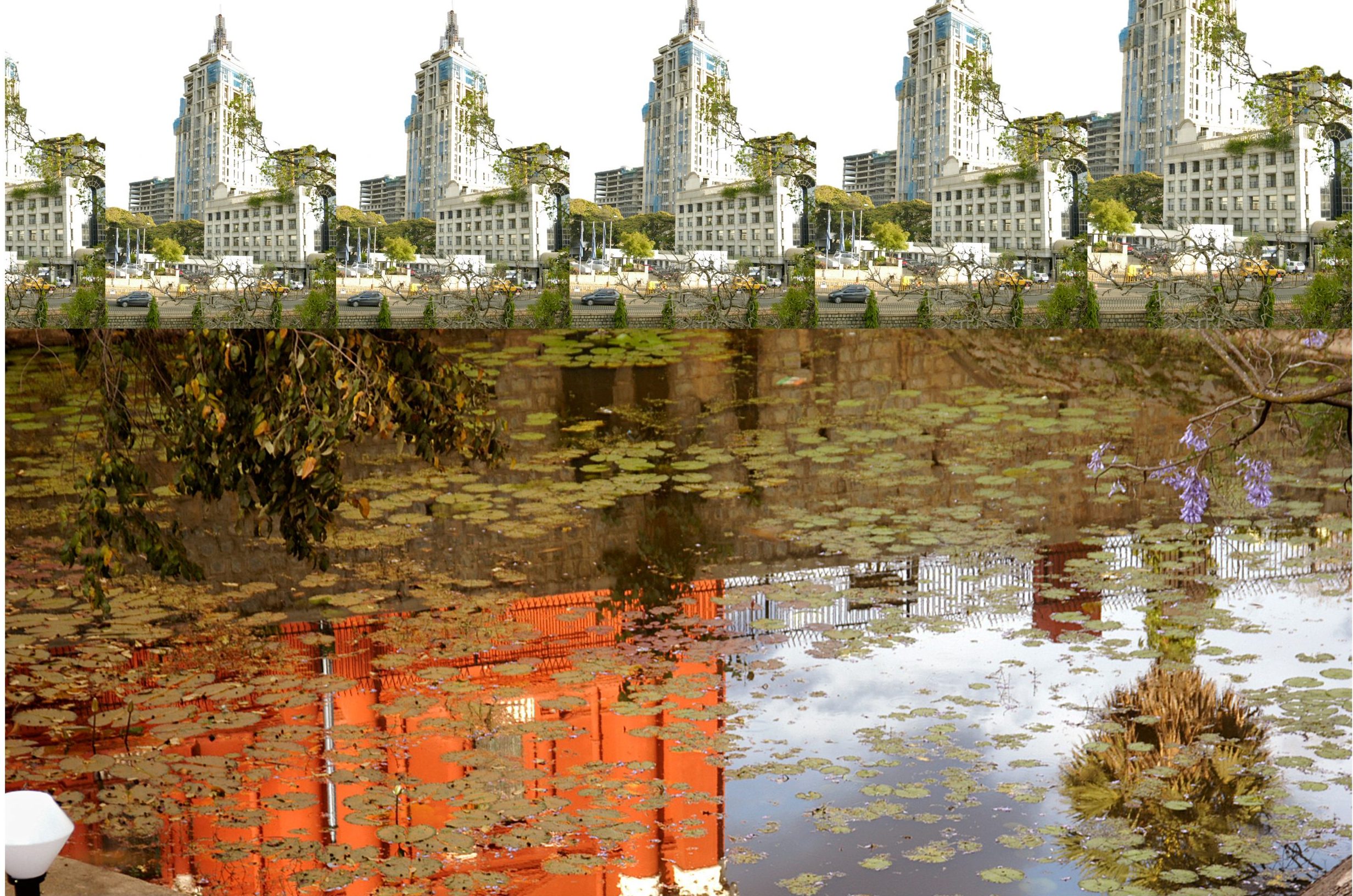Interviews
Adding a Little Twist to Textiles
Vaishnavi Kambadur
An interview with Radhika Poddar on natural fibres, vintage textiles, merchandising and more. Poddar has not only played an important role in the formation of MAP’s collection but also promotes contemporary Indian design through her lifestyle store Cinnamon.
Can you tell us about your relationship with textiles?
Yes! I grew up with all kinds of textiles because my mother used to collect vintage textiles – she used to work with a lot of weavers in Maheshwar to get saris woven, and she also had her own block printing unit. I was introduced to a lot of different kinds of textiles at a very young age.
Could you specifically talk about tie dyed textiles like ikat and bandhani? Did you grow up with them?
I distinctly remember a pink bandhani silk sari that my mother would often wear; it was amongst her favourites and she gave it to me. She also had a grey ikat sari that I think she had gotten woven especially for herself. It was by an artist, as far as I recall, and today that sari is also with me. I remember growing up with both these pieces, seeing my mother wearing them, and I have even worn a few of them myself.
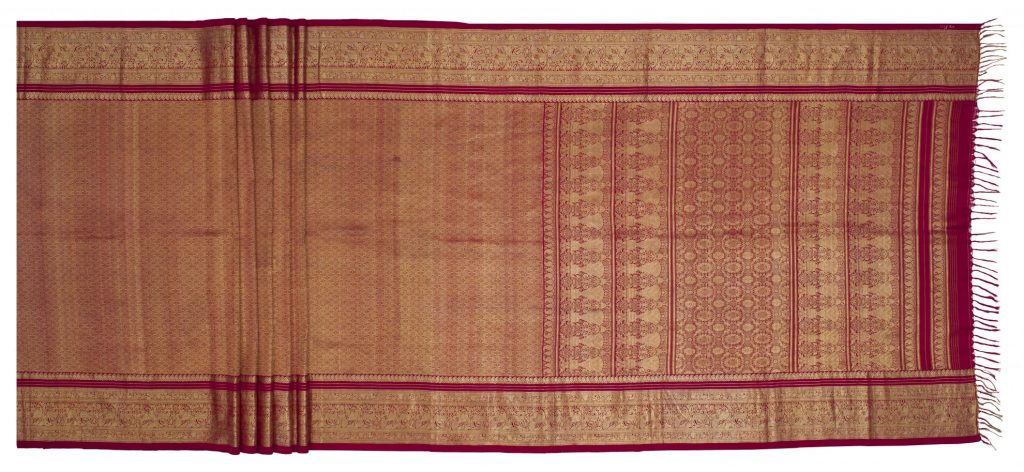
Kanchipuram Sari, 20th century, silk, gilt metal, TXT.01093. A vintage temple sari that Radhika’s dad purchased for her when she was a teenager.
Did your mother inspire you?
Absolutely! My sensibility is definitely from what I observed, but also in her demeanour and in her collection so I’m definitely inspired and influenced by her.
Wow! Tell us more about your mother’s sensibility and how you shared this love for textiles together?
Both my mother and I didn’t have formal training in either textiles or design and our interest in it definitely grew out of our passion. I think for me it was because I grew up with it and saw it all around me.
My mother’s taste in textiles was very traditional but in a contemporary way, so for instance, there was this sari she had got woven – it was a very light grey silk sari with all kinds of birds and animals woven on it in “tone on tone colour”. She got two pieces woven and she gave me one of them. Although the weaving was done in a very traditional way, the design and the motifs were very contemporary. She always liked to create something that was a little different and not just get stuff off a shop floor, and I’m very similar in that!
How are you similar?
If I want to buy a nice piece of textile or I really want a sari, I can’t just buy it from a shop because I like to create something that is a little different; if I see something I’ll always add a little twist to it. My mother had her own block printing unit and that was a lot of fun because she used to get the saris woven according to the colours that she wanted and then would also get them block printed. In her block printing too, she used several regular traditional floral motifs, but also created a whole lot of blocks and screens that were very different and contemporary. For instance, she made blocks of a telephone, of a padlock, of a regular standing fan and revolving fan, and screens of birds and butterflies that were not like the regular motif of birds and butterflies. She made many of these offbeat prints and I remember her always telling me that these were not prints that were always popular and that very few people appreciate them, but nevertheless she created them because she enjoyed doing it. She felt that even if a handful of people appreciated them, it was worth her while. She put a lot of time and energy into it, and was always creating something quirky and a little different!
I think sometimes I do that myself at Cinnamon. I too get a collection of something that may not appeal to everybody and is a little different, like a pistol on a stand, which is not everybody’s cup of tea. For me, it’s the fun of doing it and you know to “be a little off beat!”
I was going through ‘The Cinnamon Store’ online and noticed that it had a brand called ‘Lotus’ with tie-dyed clothing. What is your vision of Cinnamon? How do you situate textiles within fashion?
When I do merchandising for Cinnamon, I keep a couple of things in mind: firstly, it has to appeal to me to find space in the store. I primarily have fashion that only works with natural textiles. We don’t work with synthetics, and only with natural fibres, except for one label that we have which is doing well. Other than that, we only have natural fabrics, and for the price point, we choose not to go into the very expensive range. The shop doesn’t house bridal wear; we do more casual, classic and easy-to-wear collections. The other aspect of my aesthetic sensibility is that I don’t like anything that is too embellished, as I feel it takes away from the natural fabric itself, so I feature garments that just have a little bit of detailing.
Yes, totally! I also see this attention to detail in your choices. How do you make that selection? What is your process like?
Earlier when I did buy saris, I used to visit dealers in vintage textiles who wouldn’t have too many pieces at a time. If I liked something, I would pick it up. I have an off-white sari with silver art deco design woven all over. When I wear it for weddings today, everyone really appreciates it – they say they’ve never seen something like it! I think it’s the simple and classic that appeals to me and makes me pick a certain piece.
A popular brand for benarasis wanted to introduce a line that reproduced textiles from my collection. In fact, they had even completed two saris but the project ended there. Unfortunately, the problem with vintage textiles is that when you are draping them, they often tear. I sometimes get the torn pieces repaired to be able to wear them again.
You’re also good at repurposing and embroidering textiles and some of the kanthas before they were part of MAP’s collection were repaired by you.
When I got married, a lot of kanthas had been ripped because they had been washed. I dislike things to be damaged or not functional, so I actually sat and darned them myself. I am not a darner, and haven’t learnt the technique; I just patched them up with fabrics and fixed them so that they wouldn’t get further damaged.
It’s interesting and your personality shows through. Not everyone has the ability to fix something that is precious to them. I was once waiting in one of the rooms at your residence and noticed that the curtains in your home were ikat textiles! I also find it interesting that in Cinnamon’s interior home collection, clothing is transformed into home decor. If you could talk about the cross-connection between home interior and textiles and how you see them play around in your environment?
For curtains, I generally don’t like to go and buy metres of fabric to get them stitched. For me, curtains are a little bit more interesting than that. I had picked up the ikat curtains you mentioned from a shop in Hyderabad maybe 20 years ago and I have even asked for them again, but the shop owner said they’ve never made the same ones again because I guess it didn’t have a market. So, if you look at the curtains in my house, each one is very different – for instance, I was in Uzbekistan and I found this really long piece of fabric and I told Abhishek I’m buying this and I want to make curtains out of it. I have them in my drawing room and I can’t tell you how many people have appreciated them. So I guess, for me, it’s not that I think about the curtains specially; it’s just that textiles from different parts of the world appeal to me. Also, I think my taste is very – I don’t know if I would call it earthy – but it is rooted in tradition; anything that is traditional is something that appeals to me. I wouldn’t just go and buy a Benarasi fabric for the sake of it; there has to be something a little different about it, something that’s not necessarily with a twist, but traditional and yet is very contemporary; something that appeals to somebody your age and somebody who is 70. It has to be timeless and classic. I don’t know if that makes sense!?!
Yes, that totally makes sense!
That is the sensibility that runs across my home, my fashion sense, the food at the table. It runs through my entire language, for everything. It really is born out of who I am and that’s what it extends itself into – whether it’s my work or home or personal taste.
That’s amazing because it is the core of your work and who you are. Are you wearing a patola right now?
(laughs) This is just a fabric that I digitally printed for some of the merchandise I am doing for MAP. We are currently selling all the MAP products at Cinnamon as the museum space isn’t ready as yet. This is a digitally printed fabric – and this was a sample so I just got it made into a rubber band for my hair.
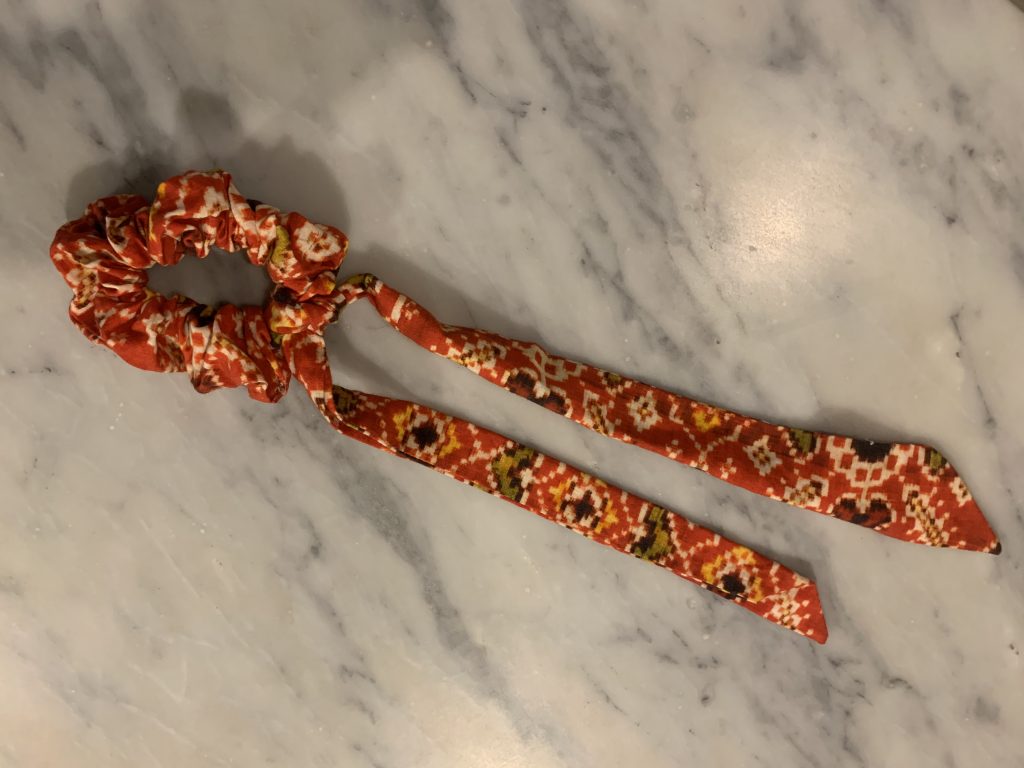
Digitally printed scrunchie that was designed by Radhika using sample fabric.
It looked like you were wearing a jacket. But now I can see! That’s really cool. Who would’ve thought that a rubber band or scrunchie could be inspired by a textile?
(laughs) Right?!
Scrunchies are in trend now.
I’ve done a whole range of them for Cinnamon now, with just sample fabrics.
Which brings me to – how do you identify a good tie-dye textile or bandhani?
I think one would first look at the size of the daana – the smaller it is, the finer the work is. It has to be ekdam chhota daana [very little seed] and not that mota kaam [thick work]. In ikat, of course a double ikat is much more precious and more difficult to do because both the warp and the weft are resist-dyed prior to weaving.
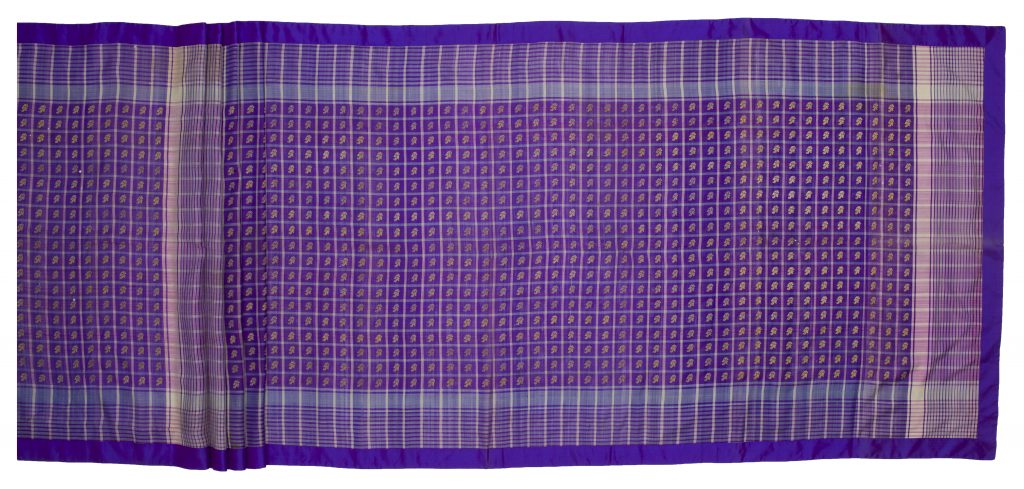
Imitation Telia Rumal sari, 20th century, silk, gilt metal, TXT.01421. This is one of Radhika’s favourite textiles from the collection.
Thank you, that’s helpful to know. In terms of MAP’s collection, is there a specific textile that really sums it up for you in terms of someone who looks at it and enjoys it?
One of my favourite pieces – it’s not a vintage piece – it’s a personal sari of mine done by Ashdeen, who creates parsi gara saris. This one that I have is black and red and it’s got cranes made on it – and it’s beautiful. Unfortunately, this design has been copied extensively, and is now all over the place! I, in fact, just messaged him a month ago and I said that this being amongst my favourite saris, I don’t feel like wearing it because this motif has been plagiarised so much.
As far as MAP’s merchandise goes, there is a jamawar shawl pattern that we have used a fair bit. We’ve got digitally printed fabrics of some of the textiles in the collection and got them converted into all types of merchandise and I have to say, it’s come out really well. It’s exciting to see that this is a shawl that I can wear and translate into toilet cases, chashma (glasses) cases and trays and boxes – it’s really exciting!
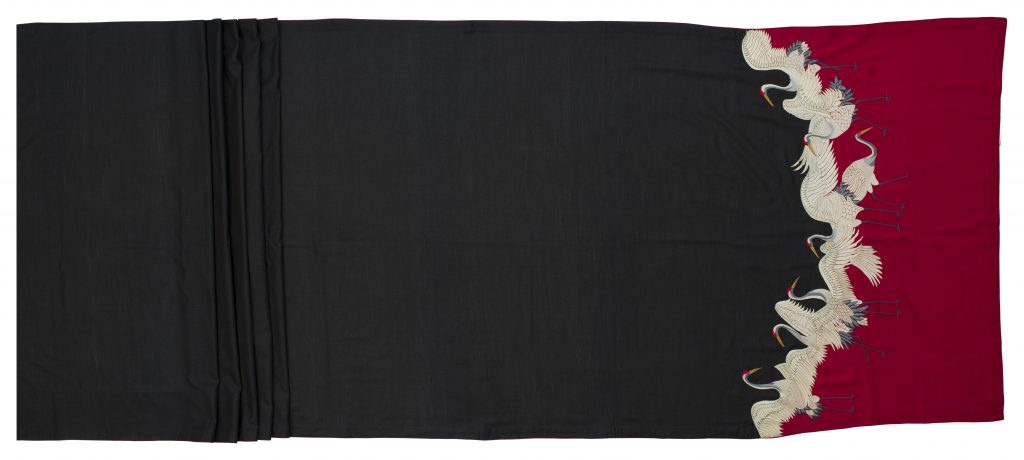
Ashdeen Z. Lilaowala, Embroidered Sari, 2004 – 2005, silk, TXT.02002. Radhika designed this sari with the designer in Delhi.
It’s quite quirky and makes it accessible to people who might not be able to afford something like a jamawar textile. Tell us about your personal wardrobe too, I noticed that you wore Issey Miyake once.
I don’t really buy international fashion as such. I mean, Issey Miyake is timeless and classic. A pair of pants or a wrap from there, you can wear it till you die as it will never go out of fashion. The other label that I enjoy wearing is COS because it’s so basic – you can wear it to work and wear it to a party. I like clothes that I can wear to a 20-person dinner, or to a 200-person party. For me, the simplicity of the garment is really what matters. Another label I really like is called Giordano Ladies, a South-Eastern label. Their designs and garments are very classic. Then there is Yacco Maricard, a Japanese designer, and the label is all over the South-East.
Thank you so much for sharing this Radhika!
As an extension to the online exhibition Painted Stitches, Woven Stories II, Vaishnavi Kambadur (assistant curator at MAP) interviewed Radhika Poddar about her textile interests. This interview has been gently edited.


